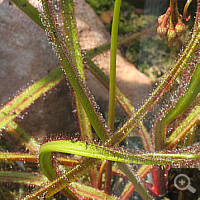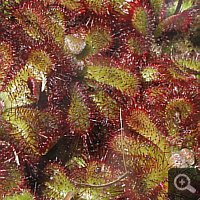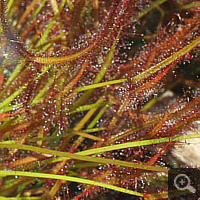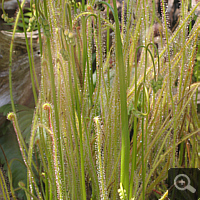Sundew (Drosera)
Overview
The genus Drosera, a member of the Sundew family, is with circa 160 species in total the third largest carnivorous genus. The genus is widespread worldwide. Main areas of distribution are escpecially Australia, but also South Africa. With one exception are moist, acid to very acid habitats populated. Droserae are found in temperate zones with a frosty winter as well as in the tropics. Most species are rosette-forming, often lying flat on earth. In addition exist also climbing or perpendicular growing species. Diameter reaches from 1 – 2 cm up to 100 cm in the case of Drosera regia.
Sundews can approximately be divided into seven large groups:
Main groups
1. temperate Droserae: Some species are frost-hardy and overwinter with a winter rosette. To this group belong the three German species Drosera anglica, Drosera intermedia and Drosera rotundifolia, the two North American Drosera filiformis and Drosera linearis, as well as Drosera binata.
2. subtropical Droserae: The vast majority of the South African species (e.g. Drosera aliciae, Drosera capensis, Drosera collinsiae, Drosera cuneifolia or Drosera slackii) are to attribute to this group. In addition some other species like Drosera binata or Drosera spatulata. In all, this is the largest group.
3. tropical Droserae: Some further species come from tropical climes. They wish preferably a high humidity, a lot of sun and higher temperatures. To this group belong the annual Drosera burmannii and Drosera indica. In addition are to class also perennial species like Drosera madagascariensis with this group.
4. pygmy Droserae: In Australia are a whole range of pygmy sundews native. Many species are annual. In winter are gemmae as speciality produced. Members are for example Drosera mannii, Drosera pygmaea, Drosera roseana or Drosera scorpioides.
5. tuberous Droserae: Also in Australia is the group of tuberous sundews native. Their habitats dry out in summer. The plants survive with hypogean tubers, from which they sprout anew after the first rainfalls. To this group belong etwa Drosera auriculata, Drosera macrophylla or Drosera peltata.
6. Queensland-Droserae: This third Australian group umfasst three species, which are to found in the tropical rainforest of the Australian state Queensland. The members are Drosera adelae, Drosera prolifera and Drosera schizandra.
7. Petiolaris-complex: The fourth group from Australia contains delicate, but very striking plants like Drosera falconeri or Drosera petiolaris.
Trap mechanism
The principle trap mechanism was already detailed described on the previous site. The sundew counts among active flypaper traps. Pediculated glands (tentacles) produce sticky drops, which base on a polysaccharide-solution. Mainly by the glitter of the dewdrops in the sun small insects are decoyed and taped. Whereas an olfactory (by the scent) enticement does not exist. Tentacles, sometimes even the whole leaf, are often distinctly movable. However, movement propensity varies clearly. Almost no movement shows for example Drosera filiformis, whereas other species as Drosera burmannii can turn around their tentacles by 180° within 1 – 2 minutes. A whole series of species, as for instance Drosera capensis, envelop finally the prey sandwich-like with their leaf. Numerous enzymes digest the ingredients and introduce them thereby to an utilisation by the plant.
Culture and propagation
The culture of the different species is partly extremely divergent, so that I submit a separate culture instruction for each group. At this point follow only a few general advices for propagation of Droserae. All species are light germinators. Many species get easily masses of seeds, other almost never. I sow the seeds on pure peat. I keep the pot in a high permanent ebb and flood irrigation system. At a light and warm place germinate almost all species within four weeks. All Drosera-seeds are light germinators, thus the seeds only scatter equally on the soil and cover in no case. Within a few months up to two years is from the seed a full-grown plant grown up.
Lots of species can be bred by leaf cuttings. Basically, there are two methods. You can give the leaf plane on peat and press on slightly. In the case of this method it is important, that the peat fulltime very moist, the humidity high and the location indeed light but without direct sunlight are. On the leaf surface evolve after two to three weeks little bulges, from which new plants emerge. If more than one cutting per leaf should be arisen, I wait until the leaf has decomposed completely before I separate the cuttings. Use for a propagation by cuttings only healthy leaves and remove possibly existing insects. Within the next weeks these would start to mould and destroy the attempt. In addition to this method works also a propagation in water well. Simply give the leaf on the water surface of a half with distilled water or with rainwater filled glass. Mostly arise with this method a little more cuttings. Because the water contains no nutrients though, the leaf must be transferred on peat – just as the first minute plants have evolved. In the case of some species work also root cuttings well. Cut for propagation a circa two to three centimetres long part of a thick root and give this circa 1 cm deep horizontal in peat. Within a few weeks grows a new plant out of the cutting.
Culture and propagation of the main groups
1. temperate Droserae: These species are very easy to cultivate. Best it happens bedded-out in a bog bed. As soil is pure peat enough. Drosera intermedia wishes a very wet location and tolerates also a temporary flooding. Drosera anglica and Drosera rotundifolia prefer a some drier location. Still drier want to stand Drosera filiformis and Drosera binata. Except Drosera binata the mentioned species are full frost-hardy and do not require a winter protection. Albeit the last-mentioned species is a little bit fussier. From the numerous forms and variants is only the single-forked species with winter protection frost-hardy. A special species is the North American Drosera linearis, which as only sundew-species demands an alkaline soil.
A propagation can take place both vegetative and generative. The seeds are frost and light germinators and thus to stratify. In winter rosettes divide partly, so that over this is ensured for recruitment. In addition, the mentioned species let breed easily by leaf cuttings, Drosera binata also by root cuttings.
2. subtropical Droserae: The subtropical species are very easy and thus also for beginners suitable. An all-year culture on the windowsill is easily possible. Pure peat as soil is enough, keep the pot in a high permanent ebb and flood irrigation system. A light place is favoured, special claims to the humidity do not exist though. In Winter the plants should stand some degrees cooler, in summer is also ideal a protected place outdoors.
A propagation works mostly by seeds, but also by leaf cuttings very well. Partly are also root cuttings possible.
3. tropical Droserae: Difficulty level of this group is various. Perennial species are more difficult, the easiest species from this subgroup is Drosera madagascariensis. Tropical Droserae wish all-the-year a warm, light and humid place. By contrast, the annual species, namely Drosera burmannii and Drosera indica, are easy. Most of all, it is important to sow the plants early in spring, so that vegetation phase till autumn is long enough in order to be able to pick new seeds, which are produced by both species easily and in large quantities. Both species grow up quickly. Drosera burmanni produces a rosette, whereas Drosera indica grows up to an erect, 30 – 40 cm high plant. In spring I sow the plants on the windowsill, prick them in May and cultivate them from then on in the garden.
4. pygmy Droserae: The propagation succeeds almost only by gemmae. Leaf cuttings do not work by this group, besides root cuttings just as little – but are out of the question because of the high root sensitivity. Seeds are produced very rarely and only in small quantities. Gemmae are produced in winter. Precondition for their production is on the one hand a cooler place as of autumn, on the other hand a dailya exposure time < 9 hours. The gemmae can be harvested, when they easily break away from the plant. Then put them easily on the soil and press on them lightly. A plant evolves quickly from a gemma.
5. tuberous Droserae: Tuberous sundews are markedly difficult. Use as soil a mixture from peat and quartz sand (1:2 to 1:3). As of autumn the pot is given in a permanent ebb and flood irrigation system. Now it requires a cool (!) and light place. From the tuber grows up quickly mostly one erect sprout, which starts often to bloom after a few months. Now seeds are produced relatively well, especially if you assist a little in pollination with the brush. In early spring the plants die back now above ground. That is the moment to take the pot from permanent ebb and flood irrigation system and to let dry out them slowly. Some growers let stand the dried pot now in the basement, other root out the tubers first and store them dark in small, closed plastic bags to protect them against desiccation.
Propagation can take place on the one hand by sowing, on the other hand by side tubers. Neither leaf nor root cuttings work.
6. Queensland-Droserae: The group of Queensland sundews is moderately difficult. In the long run, the species can only be cultivated under glass. The plants wish to stand all-the-year warm and humid (at least 80%) – indeed light but without direct sunlight. The three species have thin and sensitive leaves in common. If the plants stand too dry, then dry out first the sticky drops, shortly after the leaves. Drosera adelae and Drosera prolifera can easily be cultivated in a peat-quartz sand-mixture, wheras Drosera schizandra is cultivated best in pure sphagnum or a sphagnum-peat-mixture.
The propagation is rather easy. Drosera adelae produces quickly numerous stolons, in addition leaf and root cuttings are possible. Drosera prolifera can also be propagated by cuttings, furthermore this species produces numerous aerial layers like strawberry plants. Drosera schizandra is the most pretentious species and lets breed best by leaf cuttings. Seed production is in the case of all three species zero.
7. Petiolaris-complex: Probably the Petiolaris-complex is the most difficult group. I am myself almost unfamiliar with this group. In principle, the plants are to cultivate all-the-year extremely light and warm at a increased humidity. Furthermore a nocturnal fall of the temperature is required. The plants are exposed to a dry period at the natural habitat, during which the plant a take a dormant phase. This is to consider correspondingly in culture.




